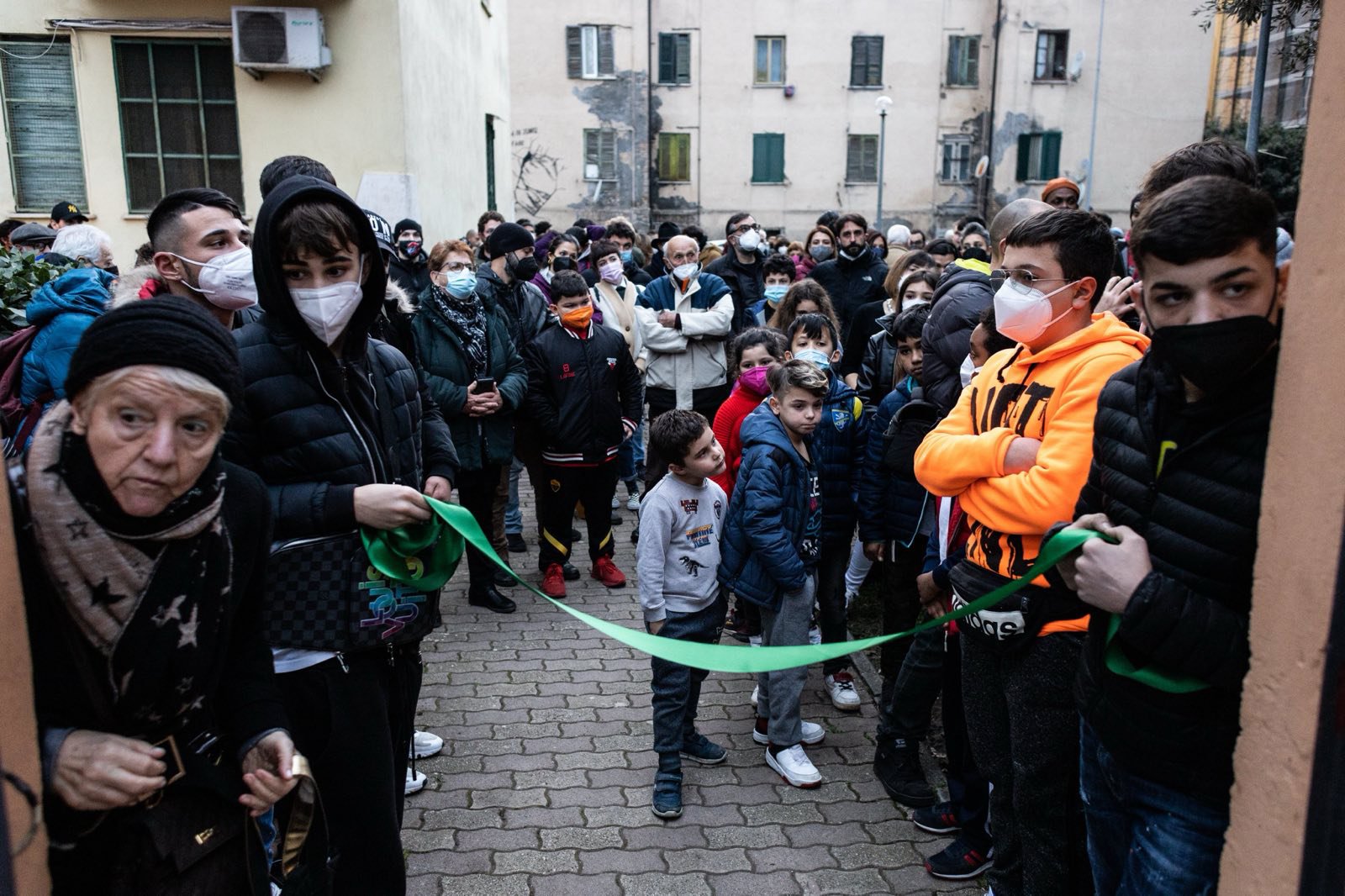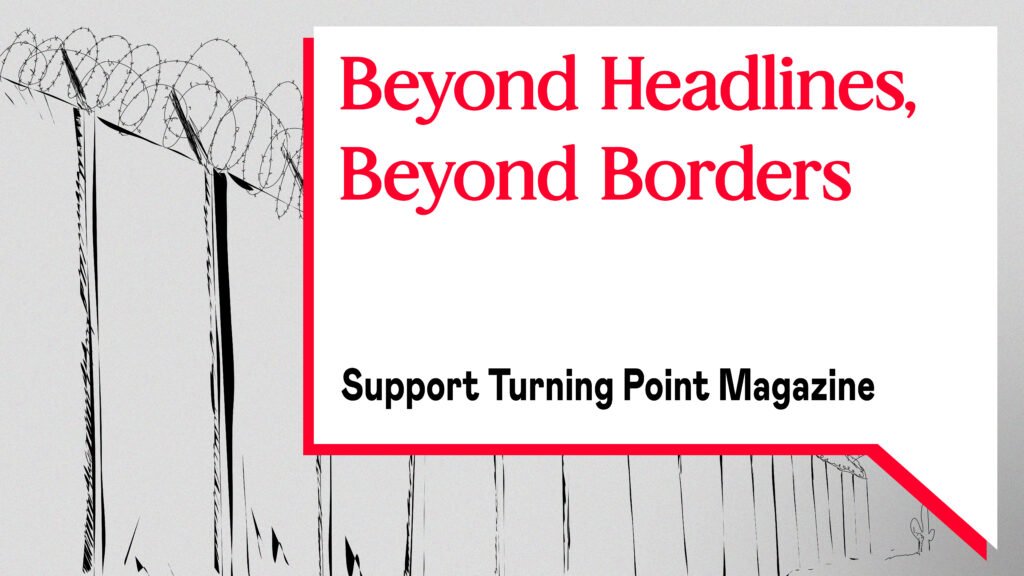Cover photo: Italy, Rome, Inauguration of neighborhood house, January 2022. © Daniele Napolitano
Italy faces a deep social crisis, nowhere is that more apparent than in the working class neighborhoods of big cities where residents face gentrification, hostile police, decaying infrastructure, and encroaching developers. In the Roman neighborhood of Quarticciolo, people are organizing to re-shape the territory, fighting against years of abandonment, using their own experience of grassroot organization to imagine and build an alternative model that could be reproduced elsewhere in the country. Nevertheless, in this small suburb of Rome you can find the same issues plaguing all working-class neighborhoods of the country: unsafe structures and a total absence of public policies. The government’s neglect of and hostility towards Italy’s working-class enclaves can also be seen in other big cities like Milan, Turin, and Naples.
Indeed, this neglect has had deadly consequences. During the course of Turning Point’s research for this article, a tragedy occurred in Naples at the Le Vele site, when a balcony collapsed on July 22 killing three people and injuring multiple others. A woman in the building described hearing a “tremendous bang, worse than an earthquake.” Another person said to the camera with watering eyes: “Everybody was screaming, there were a bunch of people under the rubble, mostly children. We took them out and then to the hospital with our cars, since there was no ambulance. Rescue units took more than an hour to arrive”. On the evening of July 22, in Scampia, a peripheric neighborhood in Naples, a walkway in the housing complex “Le vele” (The Wings Ndr) collapsed onto the floors beneath. Three people died, Roberto Abbruzzo, Margherita Della Ragione and Patrizia Della Ragione. Thirteen were injured, mostly children from the same family. The news received full national coverage and gained some international attention: Le Vele is likely the most famous public housing complex in the country and has become a symbol of Italian gangster culture. According to Italian State Institutions, the decay and the permanent crisis that Scampia has been living through for decades must be blamed on criminal activities in the territory: “Non siamo noi il problema”, the problem is not us, is written in giant graffiti on the façade of the iconic building. The slogan was written on the Le Vele structure by Berlin-based artist collective 1up crew, who visited the neighborhood in solidarity with locals. People living there always said that the power of the mob is the result of, rather than the cause of, their difficult conditions. After scrutinizing public initiatives and policies enacted on the territory, it becomes obvious that they have a point: in 2016 Naples’ municipality made a report for the project “Restart Scampia” writing that the buildings were not safe for people to live in. However, in nearly ten years nothing significant has happened to protect them. It’s difficult to say that this was an unexpected tragedy. Whether in Scampia or in any other Italian district of public residential housing (Edilizia Residenziale Pubblica, ERP), similar situations occur constantly all over Italy.
Many avoidable public safety incidents have been recorded this year. In March in Turin, a balcony collapsed from a building. Shortly after that, in another part of the city, a man was just about to pour his morning coffee when he found himself covered in ruins from the upper floor. He was rescued by his wife and daughter. In June, a family in Tuscany had to move to another town when their home was found unsafe. The month before, a similar issue affected some buildings in Pozzallo, Sicily, where the mayor ordered the evacuation of 48 apartments, but families refused to leave since there were no alternative solutions provided to them. In Rome, the biggest city in Europe, and the most populated in Italy, ERP buildings are not enough for the people in need and their structural situation, like the ones described all over the country, is tragic. Housing issues are just a small part of a process of desertification: no architectural maintenance, fewer services every year, and a total absence of long term policies.

“We all know it could have been here,” says Fabio when I ask him about what happened in Naples. He lives in Quarticciolo, in the south-east part of Rome, a much smaller and far less famous neighborhood than Scampia about 200 km away. Nevertheless, the two places share the same story as any other low-income suburb of the country. Whether famous or not, concentration of poverty, unemployment, most of the youth dropping out of school, and a lack of public transportation result in the isolation of these areas as newspapers constantly write clickbait stories about them.
Policies and activities promoted by government institutions are almost completely absent, and when any new project starts, people never know when it will be finished – if it ever will be finished – and what the outcome will be. Fabio is 61 years old and works for Ama, the municipal company in charge of waste disposal and cleaning the city: “We’re quite a bunch from the area employed there, which is ironic since they (Ama) never come here.”
No one visiting Rome nowadays could say it’s a clean city, but moving away from the center the situation gets much worse. We meet in front of his house, the contrast between the inside and outside of the building is quite pronounced: the entrance hall is spotless, freshly painted, and pristine, while the outside is not in very good shape. “Once I change the mailboxes, the renovation will be finished,” he says proudly showing us around. “I did it because if we wait for them to do it, it might happen when I’m already dead”, referring to the Territorial Housing Company (ATER), which is supposed to be responsible for these kinds of renovations.
ATERs are the regional institutions that inherited the real estate from the National Public Housing Institute (IACP), which was dismantled in 2002. However, this transfer of powers was implemented without any relocation of resources, so the new institutions took the form of Public Economic Entities, that is, entities that have to find funding for renovations and new construction on their own. Ultimately the implementation did not go well.
Remarkably, the end of any public housing policy happened when the country was governed by a so-called left-wing party. In 2022, the network Rights in the house (Diritti in casa) calculated that in Emilia Romagna—one of the wealthiest regions in Italy—ATER sold off a big part of their properties, using the funds made with it at the ratio of one new building for every four sold. In Italy, Public Residential Housing (ERP) now accounts for only 3.8% of the country’s total housing stock, too little compared to the need, and to the size of the public housing stock in other European countries of similar size such as France (16.8% of total housing stock) and the United Kingdom (17.6% of total housing stock).
“Those people died in Scampia but it could’ve happened here, or in any other ATER building,” he goes on, “In June a 12-year-old boy died in Tor Bella Monaca” another ERP neighborhood in Rome “Elevators are broken since forever; he was suffocating, and paramedics couldn’t bring the oxygen tank quick enough to save him. The father took the stairs and tried to bring them up himself on the 9th floor. How is that fair? To lose kids like that?”.
Unlike other ERP neighborhoods, such as the mentioned Tor Bella Monaca, Quarticciolo is architecturally appealing, with small buildings of three or four floors, each block being spaced by communal gardens with benches. Some are beautifully curated like his entrance hall, and some others are completely wild, likely depending on the amount of free time and will that people living there have. Quarticciolo could be a very nice place to live, but even if you’re fortunate enough to have a fixed apartment without molded walls, there are no services, and most of the shops are out of business.
Following the closure of the local market (imposed by the public administration), the arrival of large-scale retailers just outside the neighborhood gave the final hit to local family-run trade. Meeting places have also been severely curtailed: for instance, the main square was the subject of a redevelopment project that kept it inaccessible for over twenty years, until 2015.
“They tell us we’re the problem, that the public investments are lacking because of the people not paying their rent, but the last AD of ATER last summer was arrested for corruption. I’d bet that they burnt more money than all the people living in their buildings put together owe to the company.” Each place has its own story to tell, and while walking around, the streets of Quarticciolo are saying clearly that – whether he’d win his bet or not – what Fabio has to say about ATER is quite accurate.
Institutional abandonment is not the whole story these walls are telling. All around us, there are blow-ups of girls boxing in Gaza, graffiti from different artists, and a little further a marble plaque remembering an antifascist partisan “from the people living in Quarticciolo.” You can find posters announcing big block parties, meetings for heart health screening, holidays raffle, and social dinners. There’s also a mural newspaper, structured with brief articles and pictures, reporting what happened in the past months: the announcement of the opening of Micro Stamperia Quarticciolo, the shop that printed the paper, and of the Free Clinic of East Rome. There are also photos of assemblies and rallies that people have been organizing about issues like the cuts on local schools or structural damage of some buildings.
There is the criminal district that you can read about in mainstream media, there is the situation of obvious neglect by institutions, and there are all the other things that the wall newspaper writes about. All of these stories and realities coexist, they are at least partially true. But while the vicious circle of abandonment and decay repeats itself in many other popular/working-class areas in the country, as if they were doomed to be like that, what comes out from these hanging colored pieces of papers seems to be a possible alternative. Most of it comes from a collective project called Quarticciolo Ribelle the name under which many different activities regroup: a gym, an afterschool program, a free clinic, the print shop from the mural paper and a “Neighborhood committee” that organizes for housing problems and improved living conditions. Fabio is part of the latter, they’re meeting today to hang some flyers about the recent tragedy: “Public money gone, and the fault lies with those who remain under the rubble. The other day in Scampia, tomorrow where?” wrote the collective the day after the wreckage in Naples, printing and sharing on social media a statement accompanied by the picture of a destroyed plaster that came down in Quarticciolo just the same day. “The state abandons working-class neighborhoods, preferring to devalue its assets rather than allow us to live a decent life. The state abandons us because the lives of those who inhabit our neighborhoods seem not to matter. Now they (politicians NDR) cry, then again as before: more cuts, more promises, more half-finished construction sites. Until the next tragedy. We’re grieving but it’s no longer the time to close ourselves in tears. For Patrizia, for Roberto, for Margherita.”
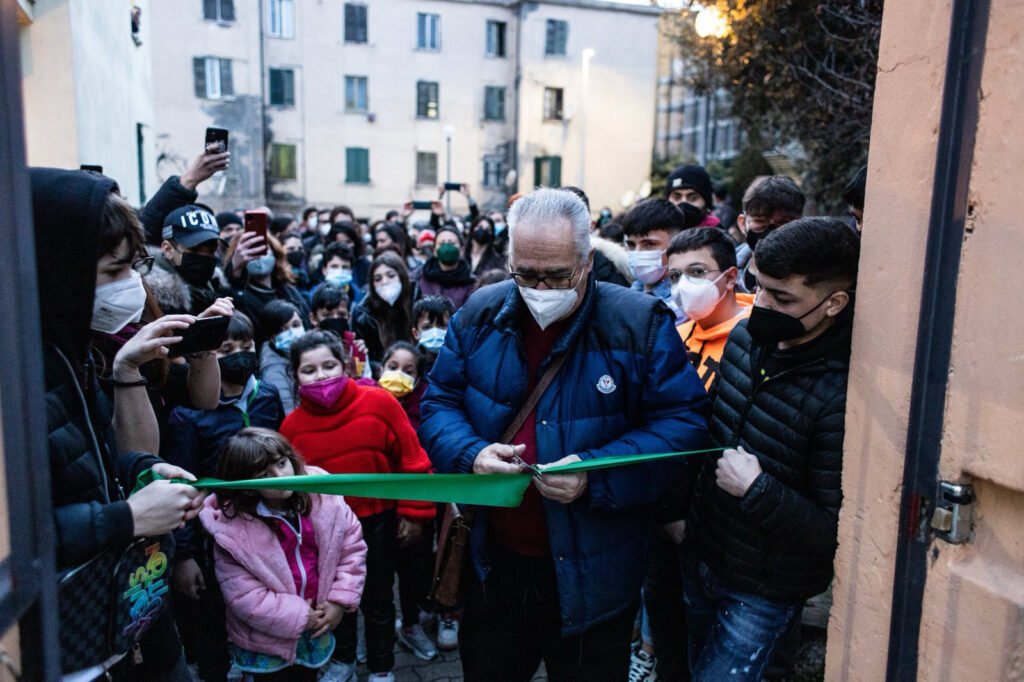
The appointment to distribute the flyers is at the Casa di Quartiere, now the hub for many of these projects from Quarticciolo Ribelle. Until its re-opening in 2022, the building was a pétanque club, the natural habitat of retired people of this country, today a place for all generations. There is a yard with many tables where one can find elders playing cards and chatting and children drawing or kicking a ball. The main structure is a fully equipped gym, but there’s also a bar with a big sitting room and a small outbuilding where the neighborhood committee organizes a desk service to help families with diverse issues, from preventing evictions to paperwork and renovations. Alessia is responsible for the help desk. Every Tuesday at 6pm she sits in the outbuilding welcoming people in, “sometimes they have a problem, sometimes they just come in to say hi.” Alessia is 37, runs a school bookshop with two other friends, and has a grant for research in urban sociology with La Sapienza, the biggest university in Rome (and also in all of Europe). She has been living in Quarticciolo since 2015, the very first year of the project. “Back then we couldn’t imagine any of this, I mean when we opened the gym almost ten years ago.”
I asked her to start from the beginning.
“In 2015 Rome was torn with a lot of social conflicts: there were clashes in many parts of the city because of the opening of new shelters for refugees and migrant people. Newspapers were telling about it as it was because these areas were especially racist, full of right-wing or fascist people, but we couldn’t believe it. It seemed too simple, like the war among the poor narrative, what does that even mean? Poverty is not a fixed entity, and it’s not just related to your income. Also, we knew people in more or less each area, and they were telling us of much more nuanced and complicated scenarios. Indeed, we were right to doubt the mainstream narrative but at the same time we couldn’t fully grasp the situation since we didn’t actually know the daily life of these neighborhoods.”
Her words remind me of a video that went viral at the time, showing a young boy confronting the fascist group Casapound. They were gathered to complain about the arrival of a group of Roma people in Torre Maura, not far from Quarticciolo. The spokesman of the fascists talks to the camera, claiming that “They must go. All the people living here agree with us”. But the boy meddles in the sentence: “I’m from here and I do not agree”. He goes on saying “You’re very smart and good with words but you are leveraging the anger of the people from this block, my block […] I believe that yesterday people took to the streets because there was the opportunity to make their voices heard by the whole of Rome and the institutions. Torre Maura lives in a situation of constant distress for a while, how can 70 Roma people be the problem?”
The fascist quickly uses the racist slur of Roma people as thieves, disputing that their arrival will make things worse, but the boy is even quicker to unmask the argument: “If a Roma person steals from me why should I reject all of them? When an Italian citizen does bad stuff you never say it, for every issue you always take the easy road and go against minorities. Well, I’m not okay with that.” Alessia used a different language, as she is a social scientist, but in their own words, they are expressing the exact same concept: complex social situations can’t be explained or solved with easy answers.
“We moved here, with some other friends, in that same period of these clashes” she continues, “we were part of the grassroots movement for housing struggle in Rome.” Housing struggle has a long tradition in Italy, that changed radically but never stopped since the 70s. “We joined the movement as students since many of us were living in horrible conditions: paying hundreds of euros every month, maybe to share a room with three other people or to live in houses with no heating and infiltration issues, with landlords taking advantage of us.” According to a Eurostat report from 2023, almost 70% of university students in Italy live at home with their parents, compared with the EU average of 17%.“Once we realized most of the scholars were in the same situation, the decision was to organize and occupy an empty building to make a student residence out of it. It was happening in many cities too and it went very well.”
Nowadays, the place Alessia is mentioning has been evicted, but the situation for students didn’t improve: in 2023 hundreds of students slept in tents in universities for weeks to protest against high rents. “After a few years, a bunch of us were about to graduate and we started thinking of what to do next. We wanted to leave space for new students in need, but at the same time, we wanted to keep living a communal life as adults. We aimed to start a new project together after graduation, we started to ask ourselves: what could we do to improve the quality of our lives? What of the many needs we have – besides the house – can we start to solve with our skills? That’s how we came up with the idea of the gym. Thousands of people can’t afford to practice sport in this city, plus we already knew about similar experiences, both in Italy and abroad.”
One person from the group was particularly passionate about this idea. Emanuele the one who later became the first gym trainer: “After graduating he spent some months in Brazil since he heard about a family that opened a gym called MM Boxe, in a very poor neighborhood of Rio Claro trying to change the social situation through sport.” After coming back and sharing his experience, the group decided to put the idea in practice: “it struck us how sport is such a powerful tool to bring people together, whether it is in a Brazilian or Italian periphery. Then we checked in with the general housing movement assembly and found out there was some space in the Quarticciolo squat. It couldn’t have been more perfect: the public pool, which was the only sports facility in the block, had just closed, so the project of the gym could fill a void that had opened in the territory. Also, as one of the biggest clashes I mentioned before had happened in the neighborhood next to Quarticciolo, we figured that if we wanted to understand the situation there was no better option than to live it. We moved there, took an abandoned boiler room, and turned it into a gym. It took one year of hard work, also Breno one of the founders of MM Boxe came to stay with us for some months to help with the opening”. While we chat in the lot, people keep coming in, some are here to join Fabio and Alessia to hand out flyers, others just came to hang out, now that the temperature allows it. Emanuele, the first gym trainer who Alessia referred to earlier, arrives. Nowadays, Palestra Popolare Quarticciolo counts more than a hundred people attending the classes.
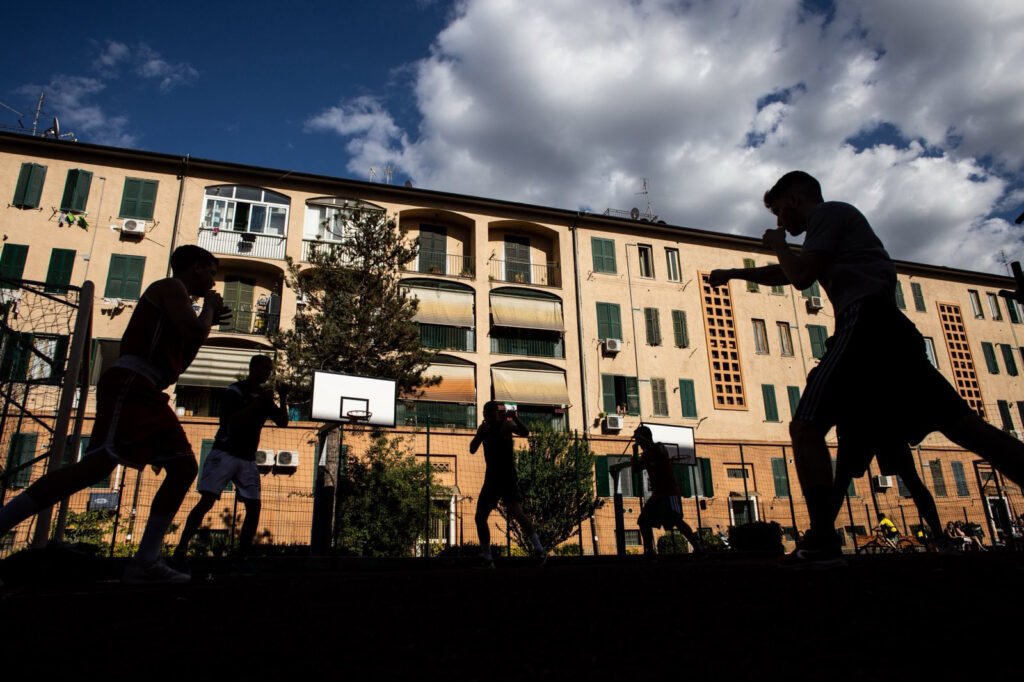
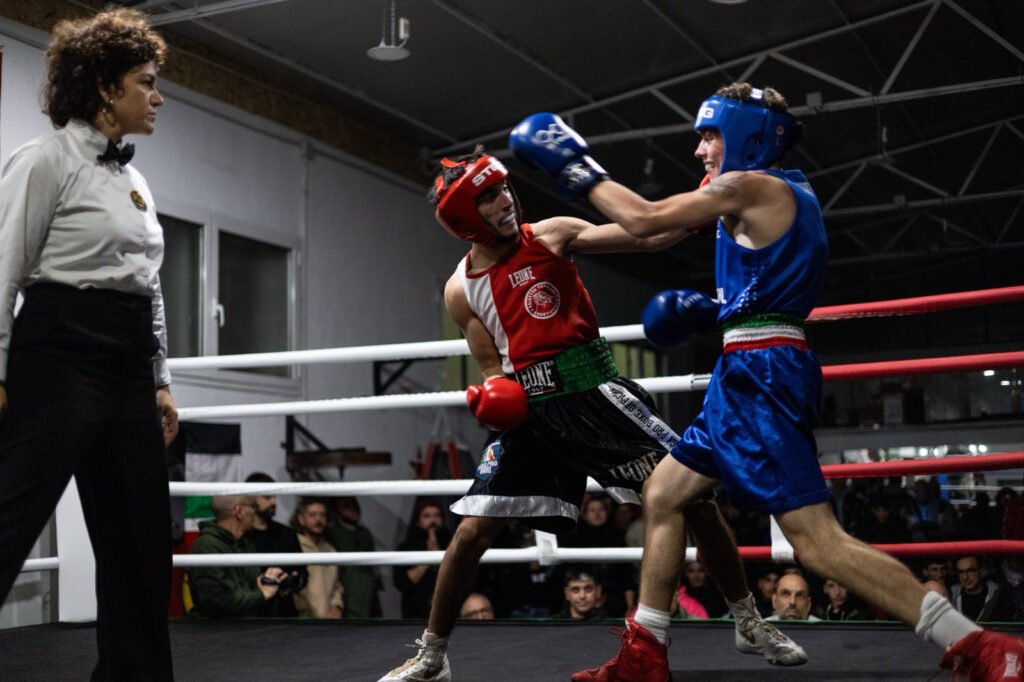
“Of course, I’m not doing this by myself, there are two more teachers for boxing classes; Fabrizio and Checco, they grew up here in this neighborhood and then grew up as athletes and coaches in this gym, and I couldn’t be prouder of that. I was their coach first but now they have the skills to teach other people,” said Emanuele.
In the yards everybody welcomes him warmly as he was away the past two weeks, summoned among the coaches of the Olympic team in a retreat before the Paris games. “Where are the kiddos? Grandpa wants to see them” asks Vittorio, who runs the bar of the community center, taking him in. Emanuele is the father of two who can often be found running the classes and holding one of them.
“They’re better at home Grandpa, it’s still too hot for them,” he says, kissing Vittorio, then greeting the rest of the visitors to the gym. Classes are suspended for summer, but the location is open for those who want to train. Nowadays, Palestra Popolare Quarticciolo is a huge, fully equipped gym in the middle of an autonomous community center, which is quite impressive after listening to Alessia: not more than three years ago it was in an abandoned ex-boiler room.
The first thing you’ll see entering is the face of Tekosher Piling, the Italian man who fell martyr in Baghouz, Syria, fighting against the Islamic State, with the People’s Defense Units (YPG), the revolutionary militia leading the Syrian Democratic Forces. Another part of the wall is covered with flags: some are from sports teams, others are political. There is the MM Boxe from Rio Claro of course, but also the Palestinian and Kurdish flags.
A bunch of people are working with exercise machines on the other side, they wave their hands and continue their training sessions. “This year eight athletes debuted in the amateur boxing circuit. It’s a big result, recognized by the Italian boxing federation itself. We have hosted many regional events with athletes of all ages and categories, in addition of course to the block party we do every year. We mount the boxing ring in the main square, and we spend the whole day celebrating the neighborhood together. It’s one of the most important days of our year, people from all the blocks come to cheer for their athletes, it’s a special moment where you can see the quality of our athletic level but most importantly, what I believe stands out, is that we’re more than a gym, we’re building a community,” said Emanuale.
In the corridor, there are pictures of these gatherings, but Emanuele wants to show me the ones from Gaza. He says that, in 2022, Fabrizio traveled to Palestine to train other coaches and to help them build new structures where people can play and train together. “The project is called ‘Boxe against the siege’ and we opt it forward with other gyms from the city. Of course, after October 7 everything changed, the place we helped build was bombed. When the war on Gaza started, we stopped all the classes to speak about Israeli’s colonial regime and the ongoing attempted genocide.”
The same happened after the femicide of Giulia Cecchettin when people gathered in the gym not for boxing but to have a group talk about patriarchy, toxic masculinity, rape culture, and everyday sexism going on in sports and society. The neighborhood committee itself started kind of in the same way, from a collective conversation in the gym, regarding the situation of one of the athletes, Milos, and his family: “Whether he likes it or not, he is a bit of a symbol of our journey, he’s come here since the very first class we did, when he was just a kid and now he’s one of our best athletes” says Emanuele. “In 2018, he and his family were violently evicted. They came with trucks and riot police, blocked off the whole neighborhood. People immediately gathered in front of their house and the injustice this family was facing was deeply felt. There was also a lot of anger for the behavior of the police, quite brutal and disrespectful. The fact is that many families are in a paradoxical situation: ATER takes so long for the allocations that people end up occupying homes that they would otherwise have a legitimate right to. There are so many situations like that around here and people got scared they might be next. That’s when we started to organize all together to struggle for better living conditions”. His passionate storytelling gets roughly interrupted by Fabio because “those flyers won’t hang by themselves.”
The building just outside the neighborhood house is completely painted with the face of Marielle Franco, a Brazilian black feminist politician who was killed in 2018 by two former police officers allegedly linked to Bolsonaro’s son. The mural was made last year.
“We were already connected to Brazil because of Breno,” explained Alessia. “That’s why when Marielle’s writings and speeches were translated, a few of us started reading them immediately. We passed the book to each other and decided to read it collectively, among women. We found ourselves in her words and experiences, of course, here is not as hard as in the Marè of Rio, the favela where she grew up, but her motto ‘I am because we are’ talks to our guts. We know that when we organize together as women, we also improve our individual lives, and we’re proud that this knowledge comes from our own experience, not just from an idealistic position. The presence of Marielle here is important also because these buildings are known in the neighborhood as the favelas, and to put them back together is one of our biggest fights so far.” She’s pointing at the block right across the street, half hidden by a big worksite.
“What happened with the favelas is a good example of how things go around here: in the late 90s the apartments were literally crumbling down, so ATER decided to blast them and rebuild everything from scratch, they moved the families and announced the working site for 2002. Years went by and the works never actually started, and it’s not like the housing company sped up their allocation process in the meantime, so the buildings ended up being squatted, and ATER just seemed to forget about it. After establishing the committee, we started doing weekly neighborhood meetings and soon it became clear that Via Ugento, the favelas, was the most urgent situation. So, we started a big mobilization with all the families living there and after some months, in 2019, we obtained the funding for renovations. We learned a lot from this experience, first and foremost, the value of what we do: without the committee, none of this would have happened, and people would be still living in the worst conditions without any responsible institution taking care of it. It is clear that as soon as we lower our guard they will disappear again, but we’re quite vigilant. Second, it is clear that the total absence of public action also deeply undermines the administrative functions of the State, which not only has lost the technical capacity to manage the public assets but also knows so little about the people living there. This was quite clear during the pandemic: none of the measures taken worked for us.”
Quarticciolo was quite televised during the pandemic as there was nothing besides the virus to report about. The media were craving for stories and a lot was actually going on in the neighborhood: “Here many people make a living with informal economy, and most of the jobs are not registered with a proper contract, meaning that if the person you work for stops paying you, there’s nothing you can do about it. Also, there are a lot of people with precarious living situations, especially because of the 2014 “Housing Plan” , the law passed during Renzi’s government.” Presented as a measure to improve the housing system in the country, what the Renzi-Lupi law actually did was to stimulate a slight economic growth in the real estate and construction industry, compounding the general issue: the law prevents the registry recognition of residence for those who live in employment, obstructing access to medical care, school enrollment for children and other basic rights, such as water and electric supply (all connected to the registration). At the same time, the law provides for the possibility for mayors to implement amendments to policy: “We – together with other groups in the city – have been fighting very hard against this law and we won. We forced the administration to overcome the ban, obligating the mayor to apply benefits for everyone who asked. Now if you demonstrate that you’ve been squatting because you’re in need they must accept your registration. We had this victory in 2019, so the years between 2014 and 2019 created a lot of “invisible people”, unable to attest to their existence in any way. So, when the pandemic happened the State was organizing emergency funding and a vaccination plan for a society they didn’t even know.”
Italy was one of the first and the most affected countries in the world by the Covid-19 pandemic, and in that period Quarticciolo became national news for how the collective managed the situation, “I think we can say that we have respected the precautions against the contagion, but at the same time we have not respected social distancing.” The latter is the specific formula that the Italian state used to tell their citizens that physical contact was one of the reasons why the virus was spreading. “They were saying that everyone must stay at home, but what if you are a family of five in 40 square meters? How is that safer or even possible? We started to behave according to our needs and opportunities, taking all the precautions needed: first, we organized food distribution since people didn’t know how to make ends meet in that period. Then the State gave this financial aid called “grocery bonus” but most of us didn’t meet the criteria mostly because of bureaucracy issues, so we organized a protest in the municipality building, demanding that all the people in need could receive the bonuses regardless. They had no other choice than to listen to us. The situation was dramatic, and they had no clue on how to solve it, while on our side we knew exactly what to do; we asked for resources but also imposed our terms to administer them. Media coverage helped us a lot, both with the bonuses and with re-opening the working site at the favelas, television made our situation known and nobody could pretend anymore that we do not exist”.
Speaking with other members of the committee about that period it is clear that organizing together did not just provide material help but also created a common understanding among people about what they could achieve together. The neighborhood is like a small town, especially compared to other zones in the city. By the time Alessia has finished the explanation, Fabio and Emanuele have already covered half of the doors of the neighborhood and we arrive in the main square, the location of the afterschool program. One of the teachers, Michele, comes out of the square.
“How is the tour going? Can I join you?” he shouts at us while approaching from the other side of the square. “The afterschool program came about like any other thing we did, by talking to each other, realizing that there was a common need, so we thought of a shared solution. Children were attending gym classes and soon it came out that families had trouble helping them with school, so we started to meet once a week to do homework together. At first, we were a few with kids of all ages, now we have different days for different school grades.”
The afterschool program also played a big role during the pandemic, when schools required devices to participate in online classes. However, these requests did not correspond to the actual possibilities of families in the neighborhood. In addition, the small spaces of ERP houses, often inhabited by large families, did not effectively allow for the simultaneous use of multiple devices, even in the few cases in which they were present. Therefore, the first actions taken by educators and parents were to enable students’ participation in daily classes with the appropriate spaces and devices. “When the lockdown finished, a lot of people came to us at the afterschool asking to help, so we could implement activities. Last year, thanks to the bonds of trust that the after-school program has built over time, we organized a protest against the downsizing of the local school. This mobilization received the attention of the Municipality of Rome, which has appealed to the Lazio Regional Administrative Court to stop the process. We still don’t know what the decision will be, we must wait for Autumn.”
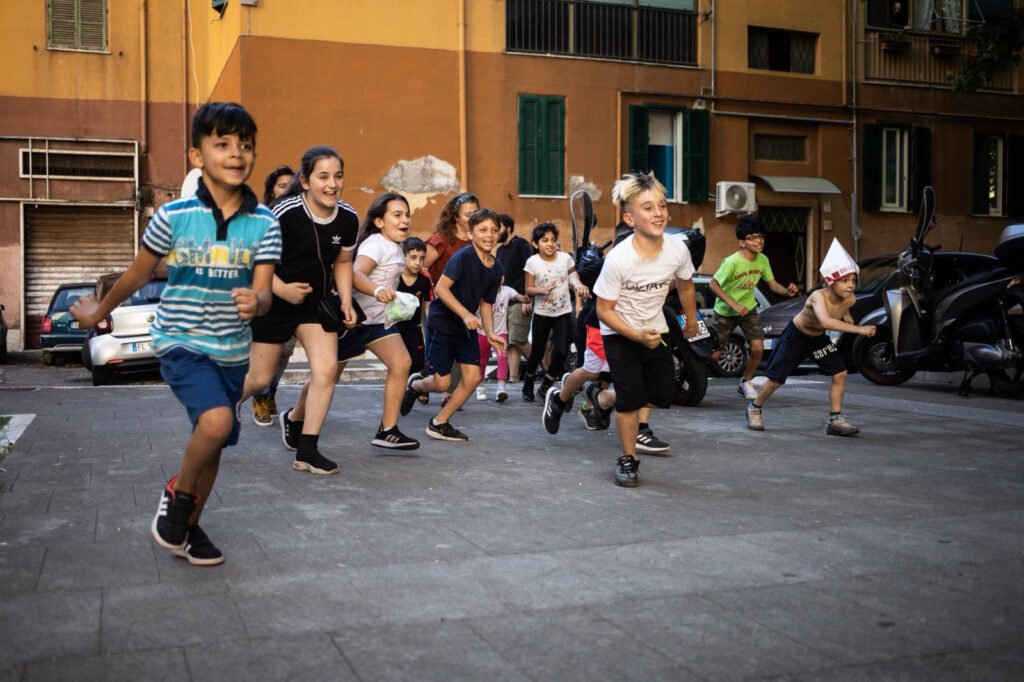
Moving from the location of the afterschool program to arrive at the edge of the neighborhood, we pass by the ex-boiler room where the gym used to be. A new banner is held on the place with the words Ambulatorio Popolare, free clinic, but you can still read the words Palestra Popolare Quarticciolo. The free clinic, which has been active for nearly a year, is the latest project which has taken hold in the neighborhood. “We’ve been organizing a public screening for common health issues like heart disease and blood pressure, there’s a service for mental health with boarded psychologists and the nutrition counselor. We did a lot of things with the children of the afterschool program too; last year with the educators we built a model of a human mouth to teach ’em how to brush and take care of their teeth.” Nowadays everything takes place in the Casa di Quartiere but when the work is finished in the same place where it all started, there will be a new project, a tangible sign of how much changed in less than a decade. “We’ll open it in autumn most probably, we didn’t want to cover the sign of the gym, we cherish our story, and at the same time we’re very happy with how much things have changed, all of this came from the people from here, this must always be remembered. Most of the time when you’re born in a neighborhood like this you’re doomed, what we try to do every day is to break that rule, to create chances for different stories,” said Alesia.
It is hard to find better words to describe what is happening in this neighborhood. Quarticciolo as a neglected suburb shares the stories of many other peripheries in Italy, but what Quarticciolo Ribelle is writing is a possible alternative plot, a different story.
Maria Edgarda Marcucci
Maria Edgarda Marcucci is an Italian author and writer. Her works focus on global conflict and social justice. She is involved in Quarticciolo Ribelle as an educator in the afterschool program.
